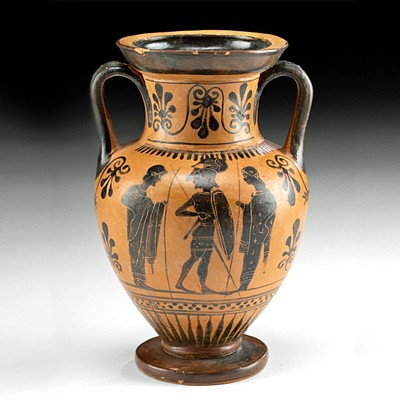Chavin Blackware Spouted Ceremonial Libation Bowl
Lot 172a
About Seller
Artemis Fine Arts
686 S Taylor Ave, Ste 106
Louisville, CO 80027
United States
Selling antiquities, ancient and ethnographic art online since 1993, Artemis Gallery specializes in Classical Antiquities (Egyptian, Greek, Roman, Near Eastern), Asian, Pre-Columbian, African / Tribal / Oceanographic art. Our extensive inventory includes pottery, stone, metal, wood, glass and textil...Read more
Categories
Estimate:
$1,600 - $2,400
Absentee vs Live bid
Two ways to bid:
- Leave a max absentee bid and the platform will bid on your behalf up to your maximum bid during the live auction.
- Bid live during the auction and your bids will be submitted real-time to the auctioneer.
Bid Increments
| Price | Bid Increment |
|---|---|
| $0 | $25 |
| $300 | $50 |
| $1,000 | $100 |
| $2,000 | $250 |
| $5,000 | $500 |
| $10,000 | $1,000 |
| $20,000 | $2,500 |
| $50,000 | $5,000 |
| $100,000 | $10,000 |
| $200,000 | $20,000 |
About Auction
By Artemis Fine Arts
Mar 9, 2023
Set Reminder
2023-03-09 10:00:00
2023-03-09 10:00:00
America/New_York
Bidsquare
Bidsquare : Exceptional Ancient, Ethnographic, & Fine Art
https://www.bidsquare.com/auctions/artemis-gallery/exceptional-ancient-ethnographic-fine-art-12354
Artemis Fine Arts info@artemisfinearts.com
Artemis Fine Arts info@artemisfinearts.com
- Lot Description
**First Time At Auction**
Pre-Columbian, North Coast Peru, Chavin / Cupisnique, ca. 900 to 200 BCE. A beautiful blackware libation bowl with a simple, elegant motif of repeated concentric circles. The rim bends very gently inward and a wide, half-circle spout projects from one side of the bowl. Ceramics from this culture are often grey-black in color and highly polished, stamped with double concentric circles which likely held a symbolic eternity or the spots on the elusive jaguar. Although the exact use of this particular bowl is unknown, its possible it was a ritualistic for sipping a sacramental brew made from San Pedro cactus. Size: 8.25" L x 2.75" H (21 cm x 7 cm)
The relationship between the Chavin culture and the Cupisnique culture is not well understood and the subject of ongoing archaeological investigations., and the names are sometimes used interchangeably. The Chavin people lived in the northern Highland Andes, and their capital, Chavin de Huantar, is an UNESCO World Heritage Site. The artwork of Chavin represents the first widespread style in the Andes. The center of Chavin de Huantar is a massive, flat-topped pyramid, surrounded by lower platforms. Between 1200 and 500 BCE the pyramid space was used for religious ceremonies. The Old Temple, constructed very early in the history of the site, consists of a series of passageways built around a circular courtyard; within were carved stone monuments showing jaguars, serpents, and other figures with transformative and/or anthropomorphic features. At the very center is a towering stone stela depicting an anthropomorphic figure with a jaguar head and a human body, believed to be Lanzon, the chief deity of Chavin. Researchers believe that worshippers ingested hallucinogenic drugs and then were led in the dark through the labyrinthine passageways - the eerie acoustics and complicated floor plan purposefully designed to disorient people before entering the central courtyard and coming abruptly face-to-face with the snarling features of the god. The San Pedro plant has hallucinogenic properties; ritual participants who ingested the substance may have perceived themselves transforming into one of several powerful animals such as jaguars or serpents.
Provenance: private Charlotte, North Carolina, USA collection; ex-Arte Primitivo, New York City, New York, USA; ex-Jean-Eugene Lions collection, #1748, Switzerland, acquired in the 1950s - 1970s
All items legal to buy/sell under U.S. Statute covering cultural patrimony Code 2600, CHAPTER 14, and are guaranteed to be as described or your money back.
A Certificate of Authenticity will accompany all winning bids.
We ship worldwide and handle all shipping in-house for your convenience.
#177011Stable hair line fissure in base and radiating from rim, and surface pitting. Otherwise intact and excellent.Condition
- Shipping Info
-
All shipping is handled in-house for your convenience. Your invoice from Artemis Gallery will include shipping calculation instructions. If in doubt, please inquire BEFORE bidding for estimated shipping costs for individual items.
-
- Buyer's Premium



 EUR
EUR CAD
CAD AUD
AUD GBP
GBP MXN
MXN HKD
HKD CNY
CNY MYR
MYR SEK
SEK SGD
SGD CHF
CHF THB
THB














